Poole Ch.P., Jr. Handbook of Superconductivity
Подождите немного. Документ загружается.

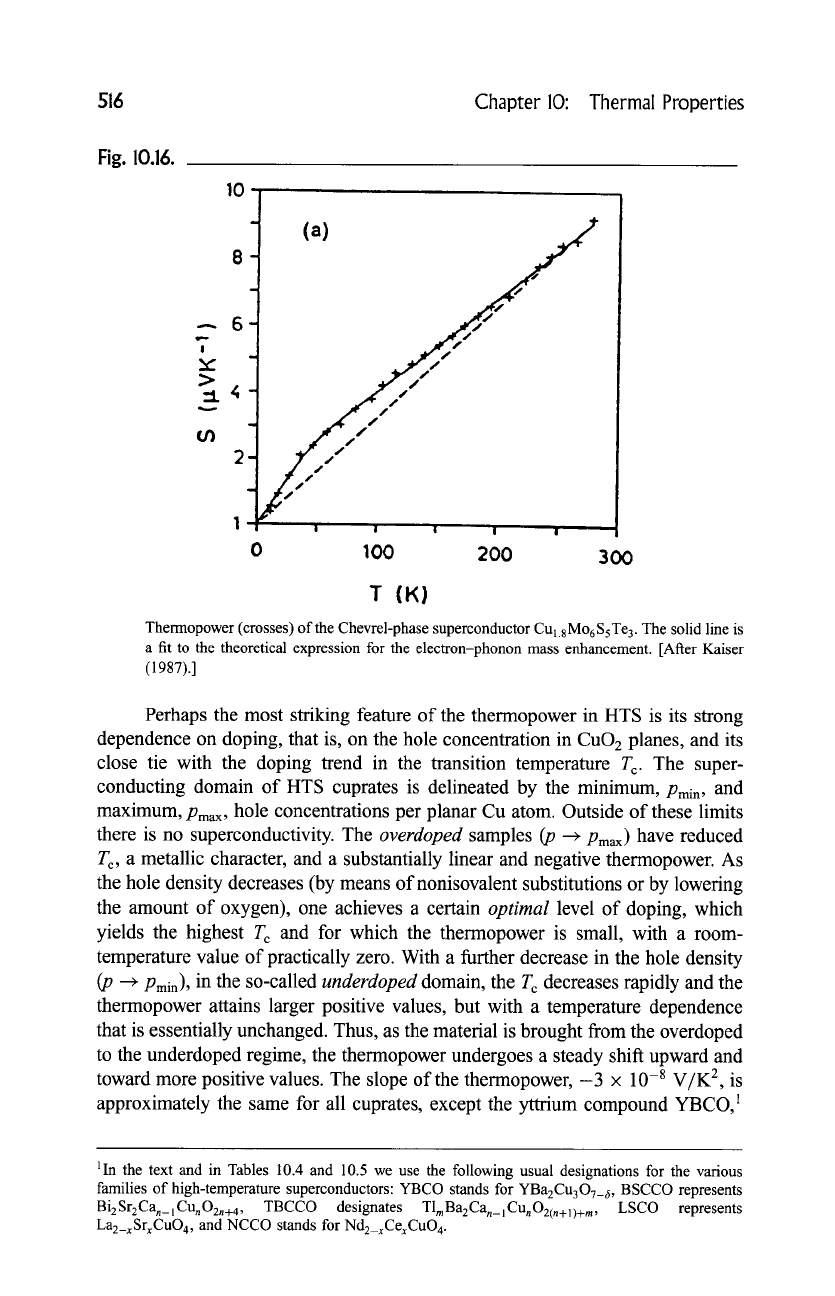
516
Chapter 10: Thermal Properties
Fig. 10.16.
10
(a)
--- 6-
J
"7 //
',x" " I/
=L 4- f
d
! -
ffl /
2- d j
1 "
t
I
~ ' I' i '" ! ' " I I"
0
100
200 300
T
(K)
Thermopower (crosses) of the Chevrel-phase superconductor Cul.gMo6S 5 Te 3. The solid line is
a fit to the theoretical expression for the electron-phonon mass enhancement. [After Kaiser
(1987).]
Perhaps the most striking feature of the thermopower in HTS is its strong
dependence on doping, that is, on the hole concentration in CuO 2 planes, and its
close tie with the doping trend in the transition temperature T c. The super-
conducting domain of HTS cuprates is delineated by the minimum, Pmin, and
maximum, Pmax, hole concentrations per planar Cu atom. Outside of these limits
there is no superconductivity. The overdoped samples (p --+ Pmax) have reduced
T c, a metallic character, and a substantially linear and negative thermopower. As
the hole density decreases (by means of nonisovalent substitutions or by lowering
the amount of oxygen), one achieves a certain optimal level of doping, which
yields the highest T c and for which the thermopower is small, with a room-
temperature value of practically zero. With a further decrease in the hole density
(P --+ Pmin), in the so-called underdoped domain, the T c decreases rapidly and the
thermopower attains larger positive values, but with a temperature dependence
that is essentially unchanged. Thus, as the material is brought from the overdoped
to the underdoped regime, the thermopower undergoes a steady shift upward and
toward more positive values. The slope of the thermopower, -3 • 10 -8 V/K 2, is
approximately the same for all cuprates, except the yttrium compound YBCO, 1
l In the text and in Tables 10.4 and 10.5 we use the following usual designations for the various
families of high-temperature superconductors: YBCO stands for YBa2Cu3OT_6, BSCCO represents
Bi2Sr2Ca., 1CunO2.+4, TBCCO designates TlmBa2Ca._ 1Cu.O2(.+l)+m, LSCO represents
La2_xSrxCuO4, and NCCO stands for Nd2_xCexCuO 4.
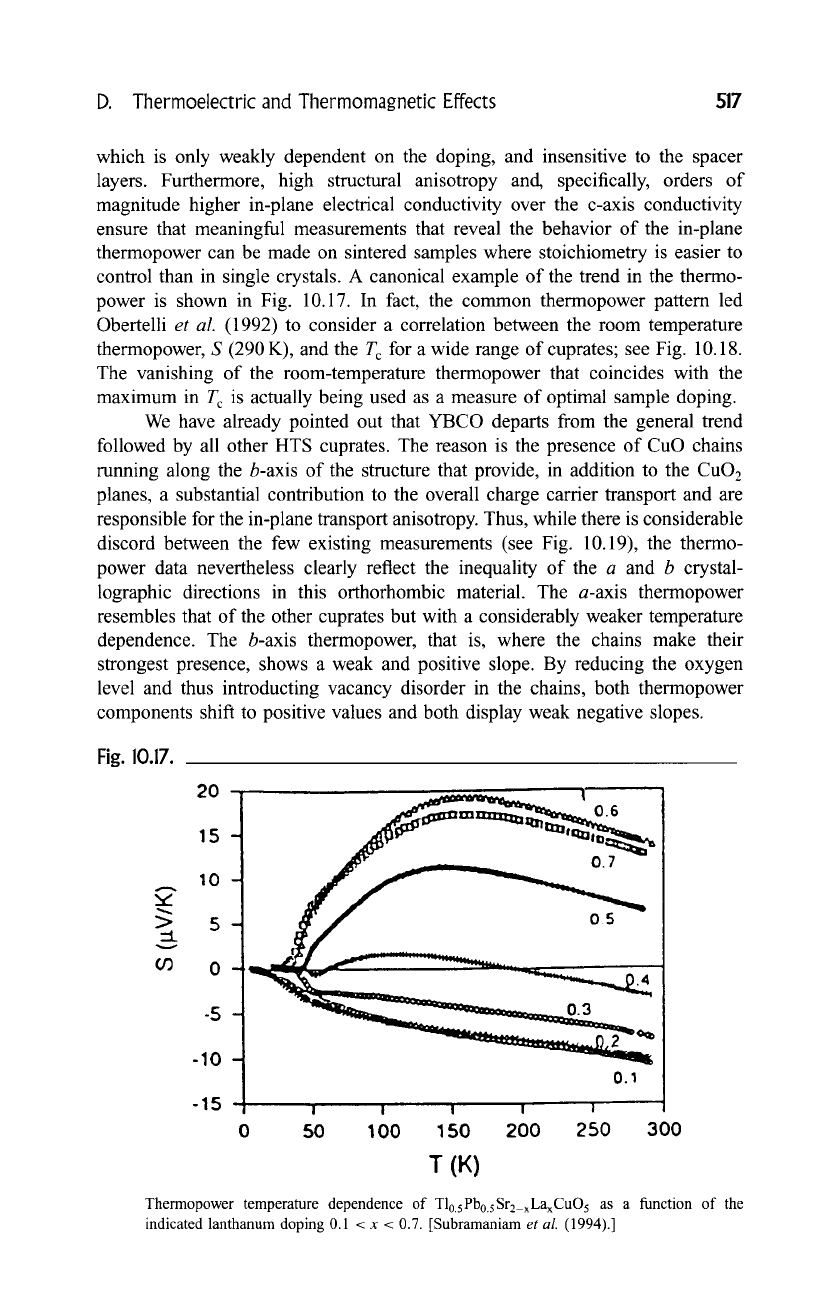
D. Thermoelectric and Thermomagnetic Effects 517
which is only weakly dependent on the doping, and insensitive to the spacer
layers. Furthermore, high structural anisotropy and, specifically, orders of
magnitude higher in-plane electrical conductivity over the c-axis conductivity
ensure that meaningful measurements that reveal the behavior of the in-plane
thermopower can be made on sintered samples where stoichiometry is easier to
control than in single crystals. A canonical example of the trend in the thermo-
power is shown in Fig. 10.17. In fact, the common thermopower pattern led
Obertelli
et al.
(1992) to consider a correlation between the room temperature
thermopower, S (290 K), and the T c for a wide range of cuprates; see Fig. 10.18.
The vanishing of the room-temperature thermopower that coincides with the
maximum in T c is actually being used as a measure of optimal sample doping.
We have already pointed out that YBCO departs from the general trend
followed by all other HTS cuprates. The reason is the presence of CuO chains
running along the b-axis of the structure that provide, in addition to the CuO 2
planes, a substantial contribution to the overall charge carrier transport and are
responsible for the in-plane transport anisotropy. Thus, while there is considerable
discord between the few existing measurements (see Fig. 10.19), the thermo-
power data nevertheless clearly reflect the inequality of the a and b crystal-
lographic directions in this orthorhombic material. The a-axis thermopower
resembles that of the other cuprates but with a considerably weaker temperature
dependence. The b-axis thermopower, that is, where the chains make their
strongest presence, shows a weak and positive slope. By reducing the oxygen
level and thus introducting vacancy disorder in the chains, both thermopower
components shift to positive values and both display weak negative slopes.
Fig. 10.17.
>.
:::t.
v
O3
2O
15
10
0.6
0.7
05
-5
-10
15
0 50
0.3
0.1
I ...... I I l a
1 O0 150 200 250 300
T (K)
Thermopower temperature dependence of T10.sPb0.sSrz_xLaxCuO 5 as a function of the
indicated lanthanum doping 0.1 < x < 0.7. [Subramaniam
et al.
(1994).]

518 Chapter 10: Thermal Properties
Fig. 10.18.
>
=L
V
0
V
09
40
30
20
10
V
-<>
I
I
<>
O
IlOA
O
O
,,
-10 -
-20
,,
-1.0
= T (max)
mc c
ve
l v
UNDERDOPED OVERDOPED
, I I ..... I
-0.5 0.0 0.5 1.0
[1 - Tc/Tc(max)]lt2
nn
Room temperature thermopower for a variety of cuprate superconductors displaying the
[1-
To~To(max)] ]/2
correlation. See original article for symbol identification. [Obertelli
et
al.
(1992).]
For completeness, Fig. 10.20 shows thermopower data on YBCO measured
perpendicular to the CuO 2 planes, that is, along the c-axis. This configuration is
experimentally quite challenging and the existing measurements are sparse.
Nevertheless, the data clearly indicate a relatively large and positive thermopower.
2. Superconducting State
We stated in the previous section that the diffusion of charge carriers down the
thermal gradient gives rise to an electric field that opposes the flow of the carriers.
In the superconducting phase there is no need for such an electric field because

D. Thermoelectric and Thermomagnetic Effects 519
Fig. 10.19.
1
> o
-1
-2
:>
::t.
u~ -2
-- I '
' I ....... 1 .... ][
i
......
I I I ~'x "
b-axls
c
- .
&
-4 ' L "
~!
_ 1, L__
50 100 150 200 2S0 300
T
(1<)
Thermopower of untwinned
YBa2Cu307_ 6
crystals in the a and b directions. Symbols are the
data of Subramaniam
et al.
(1995); the line labeled L stands for the data of Lowe
et al.
(1991),
and the line labeled C represents the data of Cohn
et al.
(1992). [Subramaniam
et al.
(1995).]
any normal current density Jn can be balanced by the counterflow of super-
current Js. Thus, thermopower of a superconductor is zero. All experimental
data, including those in Figs. 10.17 to 10.19, are fully consistent with this
hypothesis. The fact that the thermopower of a superconductor is zero (in zero
magnetic field) can be used for determination of the absolute thermopower of
individual materials such as wires intended for construction of thermocouples,
(Uher, 1987).
Although thermopower is zero in the superconducting state, the circulating
current pattern comprising the flow of the normal component Jn and the
counterflow of the supercurrent Js results in a quasiparticle imbalance near the
ends of the sample and may give rise to very weak thermoelectric effects. For
details we refer the reader to the original literature, for example, Ginzburg (1991).
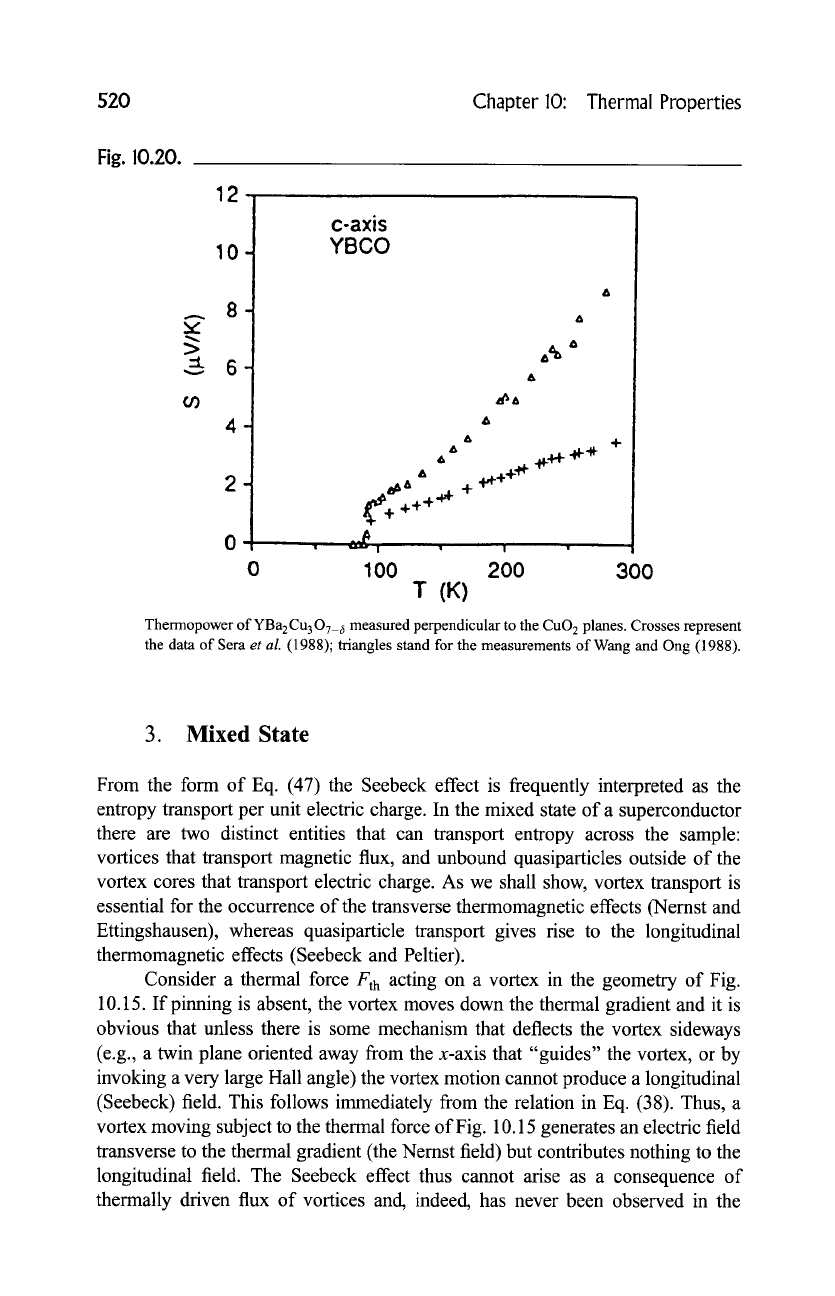
520 Chapter 10: Thermal Properties
Fig. 10.20.
12-
10-
8-
>
6-
09
4-
2-
0
c-axis
YBCO
&
6
&
a6A
+ +++++
&
A
an~
A
+ -P~'++~ ~-H- ~ "~
100 200 300
T
(K)
Thermopower of YBa2Cu 3
07_ 6
measured perpendicular to the
CuO 2
planes. Crosses represent
the data of Sera
et al.
(1988); triangles stand for the measurements of Wang and Ong (1988).
3. Mixed State
From the form of Eq. (47) the Seebeck effect is frequently interpreted as the
entropy transport per unit electric charge. In the mixed state of a superconductor
there are two distinct entities that can transport entropy across the sample:
vortices that transport magnetic flux, and unbound quasiparticles outside of the
vortex cores that transport electric charge. As we shall show, vortex transport is
essential for the occurrence of the transverse thermomagnetic effects (Nernst and
Ettingshausen), whereas quasiparticle transport gives rise to the longitudinal
thermomagnetic effects (Seebeck and Peltier).
Consider a thermal force Fth acting on a vortex in the geometry of Fig.
10.15. If pinning is absent, the vortex moves down the thermal gradient and it is
obvious that unless there is some mechanism that deflects the vortex sideways
(e.g., a twin plane oriented away from the x-axis that "guides" the vortex, or by
invoking a very large Hall angle) the vortex motion cannot produce a longitudinal
(Seebeck) field. This follows immediately from the relation in Eq. (38). Thus, a
vortex moving subject to the thermal force of Fig. 10.15 generates an electric field
transverse to the thermal gradient (the Nernst field) but contributes nothing to the
longitudinal field. The Seebeck effect thus cannot arise as a consequence of
thermally driven flux of vortices and, indeed, has never been observed in the
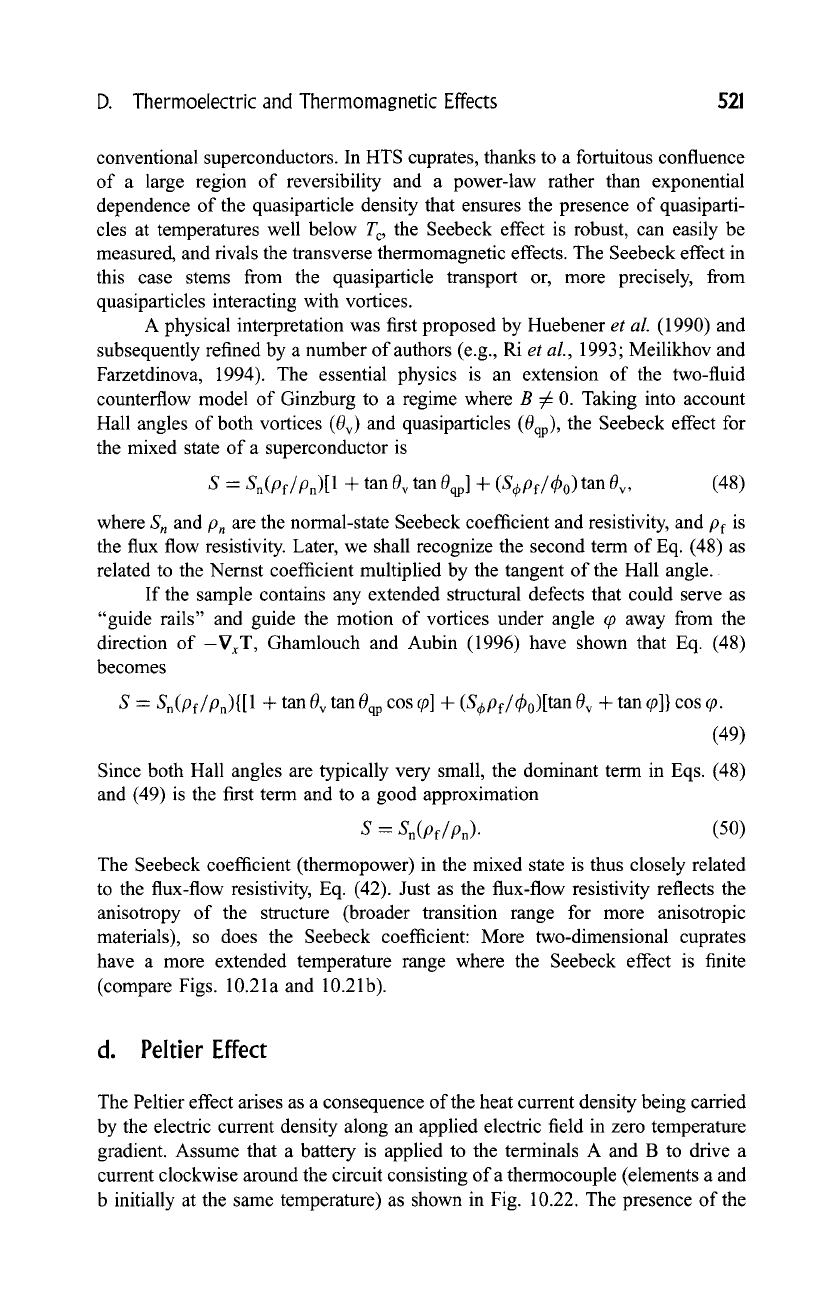
D. Thermoelectric and Thermomagnetic Effects
521
conventional superconductors. In HTS cuprates, thanks to a fortuitous confluence
of a large region of reversibility and a power-law rather than exponential
dependence of the quasiparticle density that ensures the presence of quasiparti-
cles at temperatures well below Tc, the Seebeck effect is robust, can easily be
measured, and rivals the transverse thermomagnetic effects. The Seebeck effect in
this case stems from the quasiparticle transport or, more precisely, from
quasiparticles interacting with vortices.
A physical interpretation was first proposed by Huebener
et al.
(1990) and
subsequently refined by a number of authors (e.g., Ri
et aL,
1993; Meilikhov and
Farzetdinova, 1994). The essential physics is an extension of the two-fluid
counterflow model of Ginzburg to a regime where B r 0. Taking into account
Hall angles of both vortices (0v) and quasiparticles (0qp), the Seebeck effect for
the mixed state of a superconductor is
S = Sn(pf/pn)[1 -t-
tan 0 v tan 0qp] +
(S4)pf/d/)o)tan 0 v,
(48)
where
Sn
and
Pn
are the normal-state Seebeck coefficient and resistivity, and pf is
the flux flow resistivity. Later, we shall recognize the second term of Eq. (48) as
related to the Nemst coefficient multiplied by the tangent of the Hall angle.
If the sample contains any extended structural defects that could serve as
"guide rails" and guide the motion of vortices under angle q~ away from the
direction of-Vx T, Ghamlouch and Aubin (1996) have shown that Eq. (48)
becomes
S = Sn(pf/pn){[1 +
tan 0 v tan 0qp cos (p] +
(S4)pf/dPo)[tan
0 v + tan q~]} cos q0.
(49)
Since both Hall angles are typically very small, the dominant term in Eqs. (48)
and (49) is the first term and to a good approximation
S = Sn(pf/pn).
(50)
The Seebeck coefficient (thermopower) in the mixed state is thus closely related
to the flux-flow resistivity, Eq. (42). Just as the flux-flow resistivity reflects the
anisotropy of the structure (broader transition range for more anisotropic
materials), so does the Seebeck coefficient: More two-dimensional cuprates
have a more extended temperature range where the Seebeck effect is finite
(compare Figs. 10.21 a and 10.21 b).
d. Peltier Effect
The Peltier effect arises as a consequence of the heat current density being carried
by the electric current density along an applied electric field in zero temperature
gradient. Assume that a battery is applied to the terminals A and B to drive a
current clockwise around the circuit consisting of a thermocouple (elements a and
b initially at the same temperature) as shown in Fig. 10.22. The presence of the
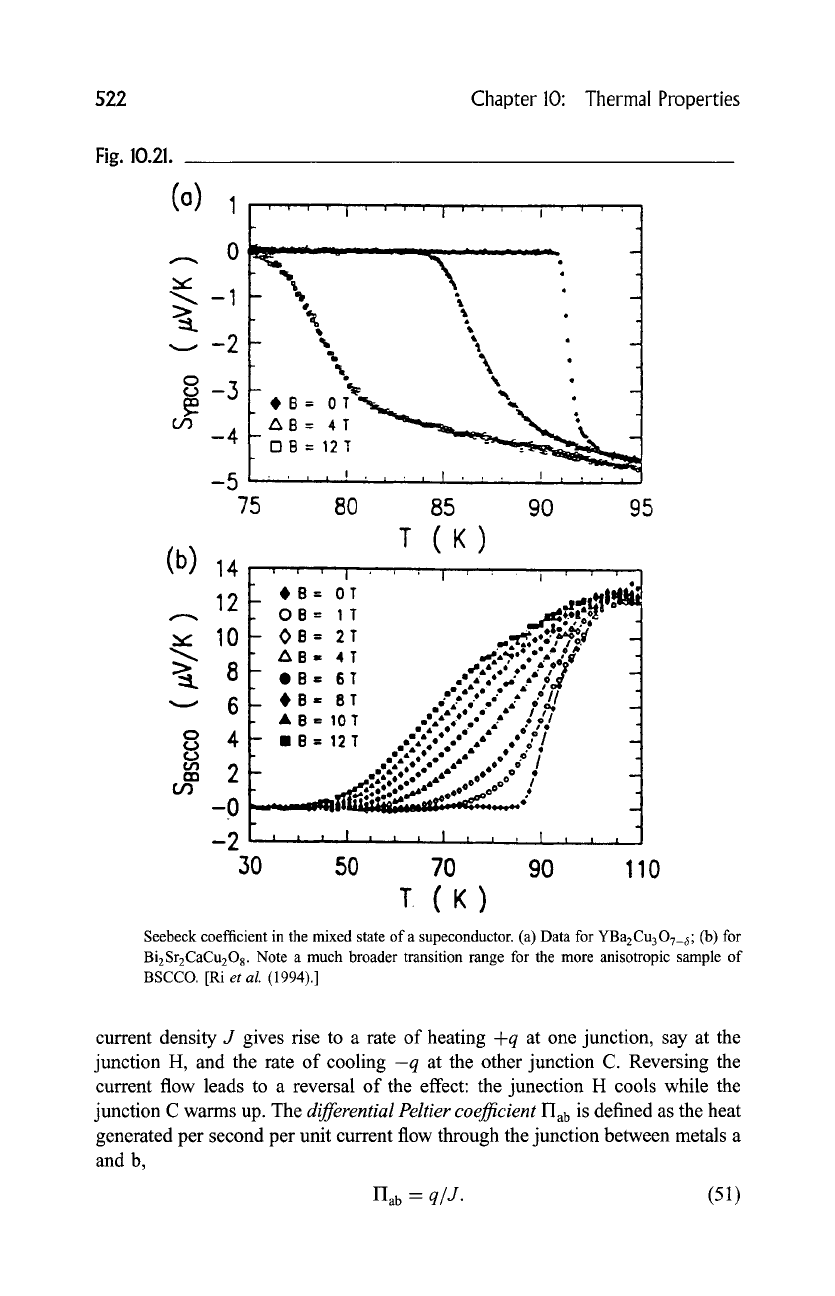
522
Chapter
10:
Thermal Properties
Fig. 10.21.
,,~ '~ ~ . "
~-I
- ,b ~
-
8
-2 ~ ~ ~ " -
%
9 . \ 9 .
o-3-
"~ ,,
. -
)O= 0T ,.
9
LIB= 41"
c/~ -4 -OB= 12T
-5
'''' '! ' ' .... ) ' ; ' J ....
75 80 85 90 95
T (K)
(b) 14 ,, ,", ...,,, ,.....,,, ........ ,,
_
)
e
=
o T
a.,,.~l~
12
o B = 1 T j~.l'~'
v
10
-
OB=
2T
..;r#..., ,o: -
9 9 em_.A e~
A B ,, 4 T ,~.,-?9 9 ..-,,g,e "
8
~A .- .---
9 I l " &
' ,~ll
6
- ,e= 8T .'~," ," "','~ 9 -
9 e -- ~0 T .'.':".'"
z
/,"7 -
8 4 - - "'"" " ":/
16- 12T
.-.,,*.-" ." .*.,.
9 9 _e 9 - 9 ~ _
9 .'Z,*'.-" .," .o~ ,," I
-2 : ' ' ' I ' ' ' I , , , ,
....
30 50 70 90 110
T,(K)
Seebeck coefficient in the mixed state of a supeconductor. (a) Data for YBa2Cu307_~; (b) for
Bi2Sr2CaCu208. Note a much broader transition range for the more anisotropic sample of
BSCCO. [Ri
et al.
(1994).]
current density J gives rise to a rate of heating +q at one junction, say at the
junction H, and the rate of cooling -q at the other junction C. Reversing the
current flow leads to a reversal of the effect: the junection H cools while the
junction C warms up. The
differential Peltier coefficient
Hab is defined as the heat
generated per second per unit current flow through the junction between metals a
and b,
IIab
=
q/J.
(51)
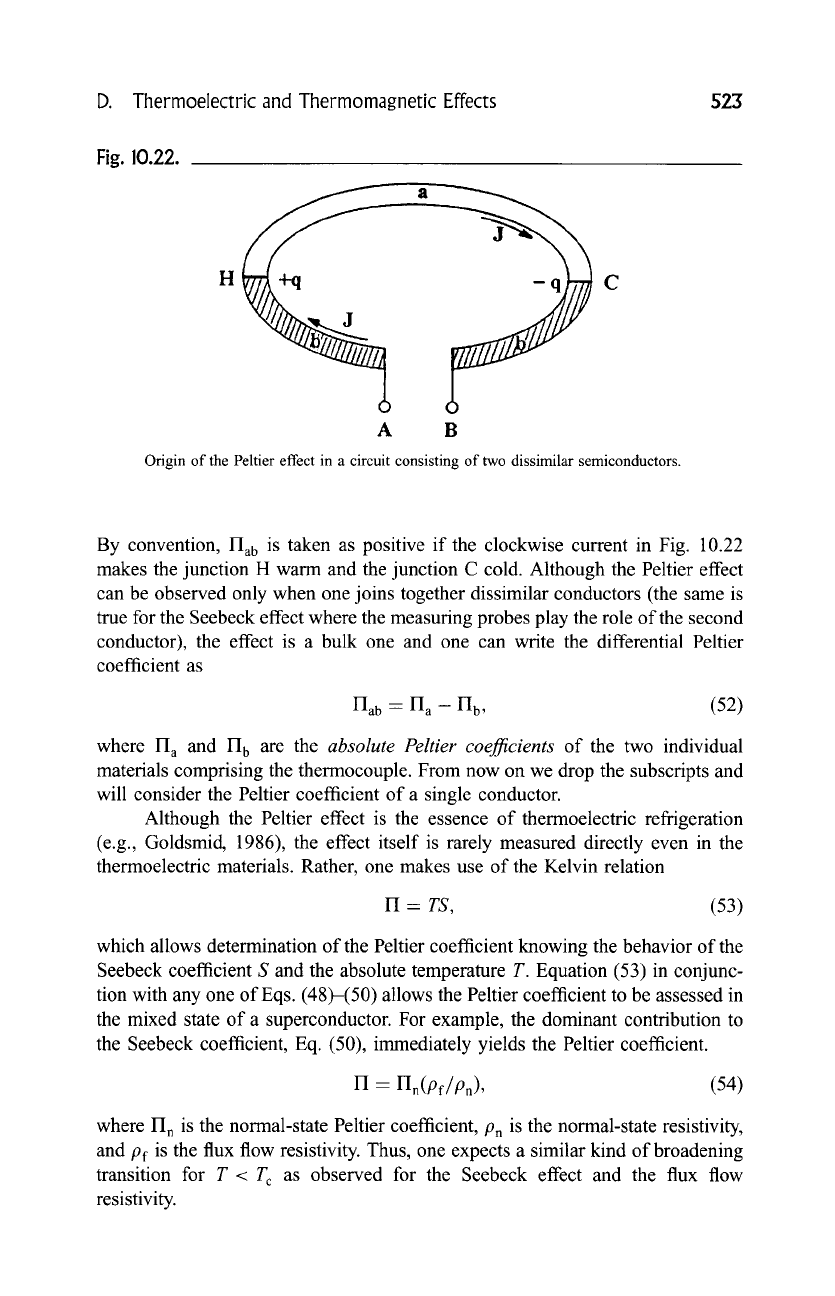
D. Thermoelectric and Thermomagnetic Effects 52.3
Fig.
10.22.
H
+q -q
C
A B
Origin of the Peltier effect in a circuit consisting of two dissimilar semiconductors.
By convention, liab is taken as positive if the clockwise current in Fig. 10.22
makes the junction H warm and the junction C cold. Although the Peltier effect
can be observed only when one joins together dissimilar conductors (the same is
true for the Seebeck effect where the measuring probes play the role of the second
conductor), the effect is a bulk one and one can write the differential Peltier
coefficient as
lIab • lia -- lib,
(52)
where
l-I a
and
II b are
the
absolute Peltier coefficients
of the two individual
materials comprising the thermocouple. From now on we drop the subscripts and
will consider the Peltier coefficient of a single conductor.
Although the Peltier effect is the essence of thermoelectric refrigeration
(e.g., Goldsmid, 1986), the effect itself is rarely measured directly even in the
thermoelectric materials. Rather, one makes use of the Kelvin relation
n = rs, (53)
which allows determination of the Peltier coefficient knowing the behavior of the
Seebeck coefficient S and the absolute temperature T. Equation (53) in conjunc-
tion with any one of Eqs. (48)-(50) allows the Peltier coefficient to be assessed in
the mixed state of a superconductor. For example, the dominant contribution to
the Seebeck coefficient, Eq. (50), immediately yields the Peltier coefficient.
li = I-In(pf/pn),
(54)
where
1-I n
is the normal-state Peltier coefficient, Pn is the normal-state resistivity,
and Pr is the flux flow resistivity. Thus, one expects a similar kind of broadening
transition for T < T c as observed for the Seebeck effect and the flux flow
resistivity.
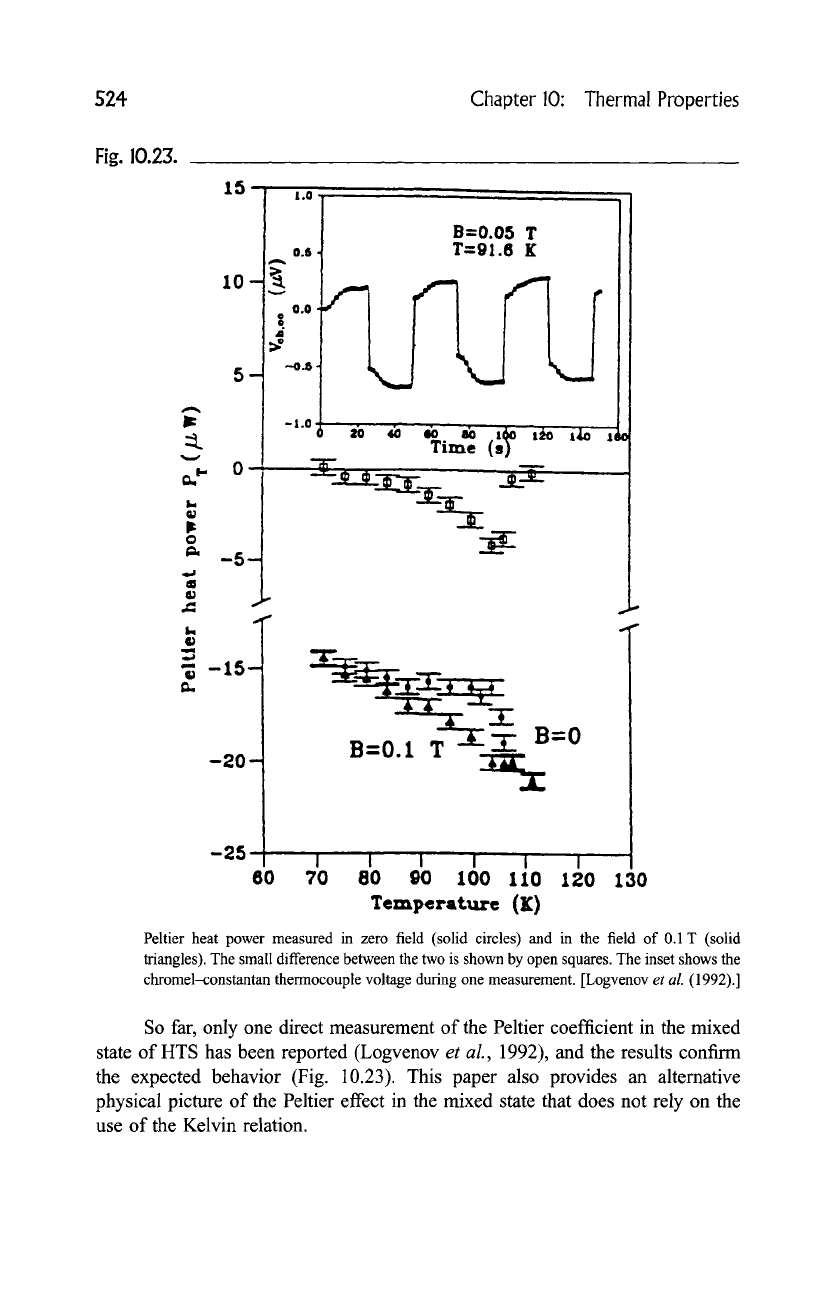
524
Chapter
10:
Thermal Properties
Fig.
10.23.
15-
10-
m
A
l'a I B=0.05 T
A ~ ! T=91.6 K
o 1.0
Time (s
_
0
##
"~
-15-
-20
-25
6O
T
B=0.1 T -~ ~ B=0
l" , , , 1
70 80 90 I00 II0
Temperature (K)
a
!
120 130
Peltier heat power measured in zero field (solid circles) and in the field of 0.1 T (solid
triangles). The small difference between the two is shown by open squares. The inset shows the
chromel-constantan thermocouple voltage during one measurement. [Logvenov
et al. (1992).]
So far, only one direct measurement of the Peltier coefficient in the mixed
state of HTS has been reported (Logvenov
et al.,
1992), and the results confirm
the expected behavior (Fig. 10.23). This paper also provides an alternative
physical picture of the Peltier effect in the mixed state that does not rely on the
use of the Kelvin relation.
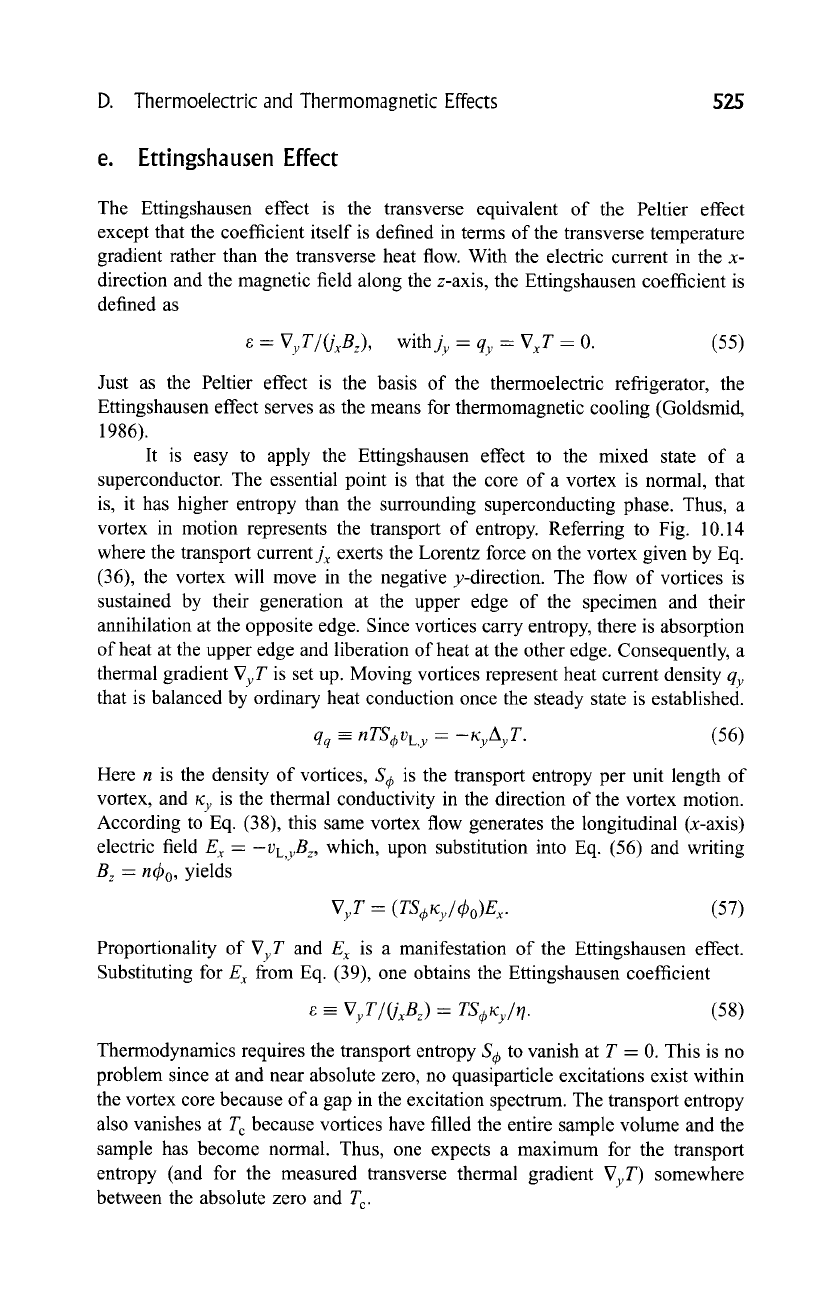
D. Thermoelectric and Thermomagnetic Effects
525
e. Ettingshausen Effect
The Ettingshausen effect is the transverse equivalent of the Peltier effect
except that the coefficient itself is defined in terms of the transverse temperature
gradient rather than the transverse heat flow. With the electric current in the x-
direction and the magnetic field along the z-axis, the Ettingshausen coefficient is
defined as
e = VyV/(jxBz),
withjy =
qy = Vx T
= 0. (55)
Just as the Peltier effect is the basis of the thermoelectric refrigerator, the
Ettingshausen effect serves as the means for thermomagnetic cooling (Goldsmid,
1986).
It is easy to apply the Ettingshausen effect to the mixed state of a
superconductor. The essential point is that the core of a vortex is normal, that
is, it has higher entropy than the surrounding superconducting phase. Thus, a
vortex in motion represents the transport of entropy. Referring to Fig. 10.14
where the transport current Jx exerts the Lorentz force on the vortex given by Eq.
(36), the vortex will move in the negative y-direction. The flow of vortices is
sustained by their generation at the upper edge of the specimen and their
annihilation at the opposite edge. Since vortices carry entropy, there is absorption
of heat at the upper edge and liberation of heat at the other edge. Consequently, a
thermal gradient
VyT
is set up. Moving vortices represent heat current density
qy
that is balanced by ordinary heat conduction once the steady state is established.
qq =_ n TS4) VL.y = - tCyAyT.
(56)
Here n is the density of vortices, S+ is the transport entropy per unit length of
vortex, and toy is the thermal conductivity in the direction of the vortex motion.
According to Eq. (38), this same vortex flow generates the longitudinal (x-axis)
electric field
E x =--VL,yBz,
which, upon substitution into Eq. (56) and writing
B z = nd?o,
yields
VyT = (rs4~Cy/C~o)E x.
(57)
Proportionality of
7yT
and Ex is a manifestation of the Ettingshausen effect.
Substituting for E~ from Eq. (39), one obtains the Ettingshausen coefficient
- %r/(i~Bz) = rs~/~.
(58)
Thermodynamics requires the transport entropy S~ to vanish at T = 0. This is no
problem since at and near absolute zero, no quasiparticle excitations exist within
the vortex core because of a gap in the excitation spectrum. The transport entropy
also vanishes at T c because vortices have filled the entire sample volume and the
sample has become normal. Thus, one expects a maximum for the transport
entropy (and for the measured transverse thermal gradient
VyT)
somewhere
between the absolute zero and T c.
